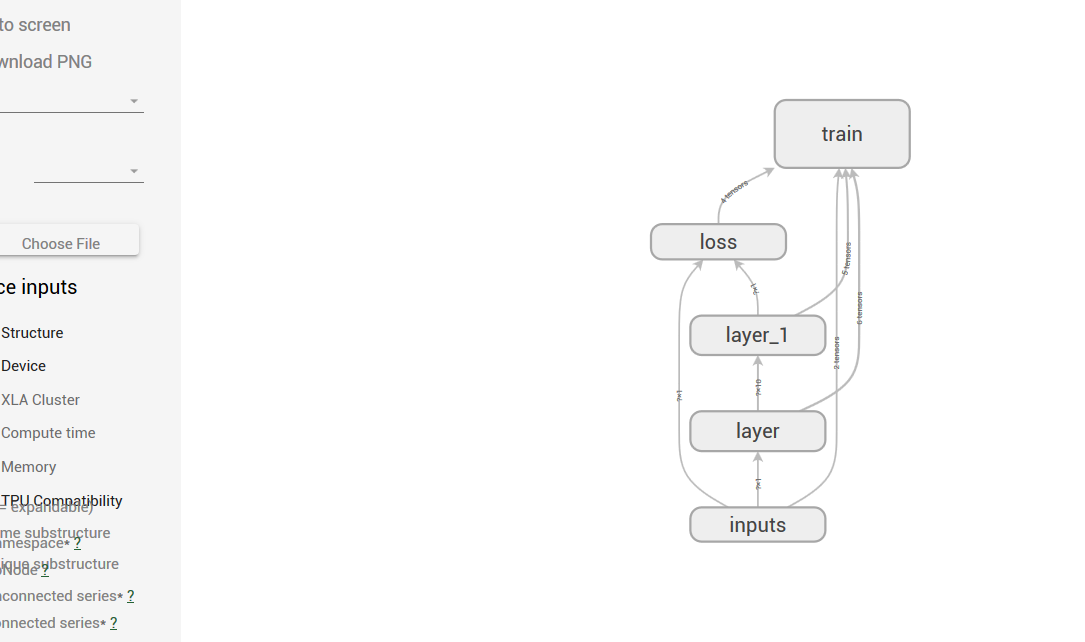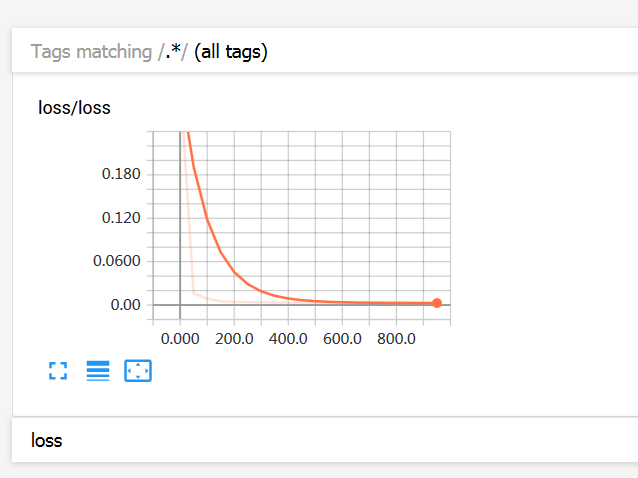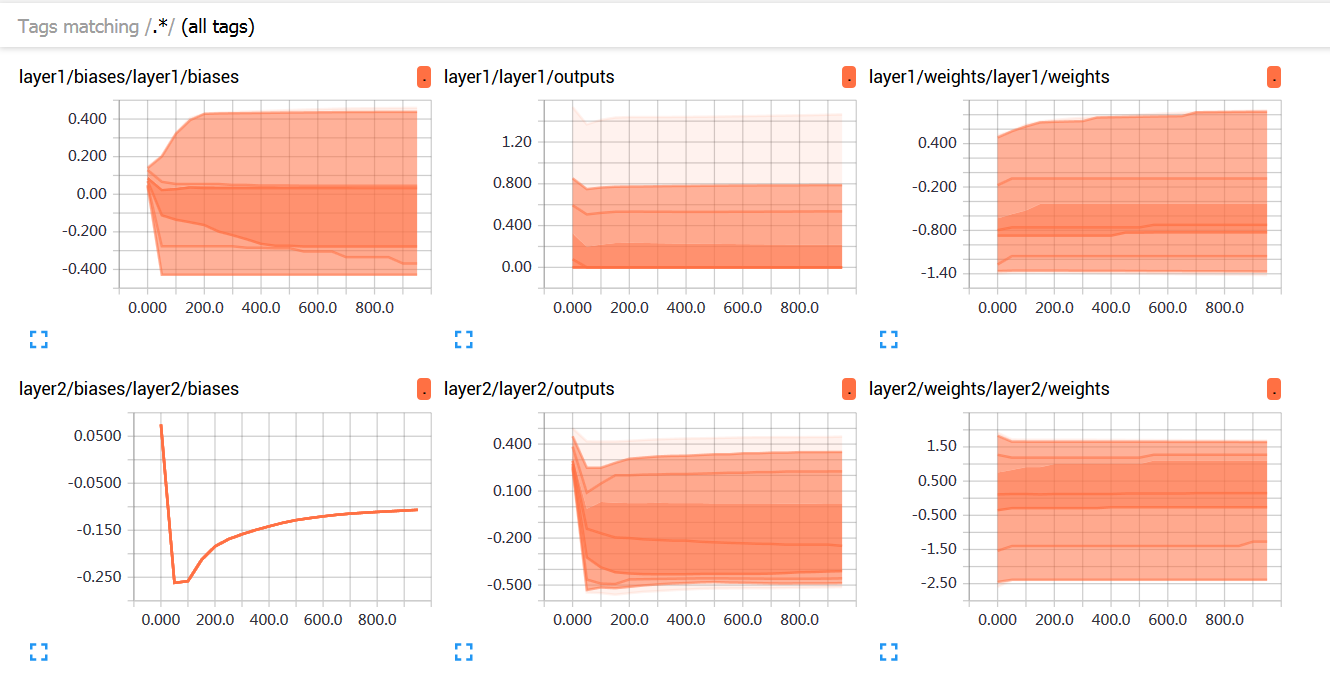TensorFlow基础笔记(9) Tensorboard可视化显示以及查看pb meta模型文件的方法
参考: http://blog.csdn.net/l18930738887/article/details/55000008
http://www.jianshu.com/p/19bb60b52dad
http://blog.csdn.net/sinat_33761963/article/details/62433234
import tensorflow as tf
import numpy as np
def add_layer(inputs, in_size, out_size, n_layer, activation_function=None):
# add one more layer and return the output of this layer
layer_name = 'layer%s' % n_layer
with tf.name_scope(layer_name):
with tf.name_scope('weights'):
Weights = tf.Variable(tf.random_normal([in_size, out_size]), name='W')
tf.summary.histogram(layer_name + '/weights', Weights)
with tf.name_scope('biases'):
biases = tf.Variable(tf.zeros([1, out_size]) + 0.1, name='b')
tf.summary.histogram(layer_name + '/biases', biases)
with tf.name_scope('Wx_plus_b'):
Wx_plus_b = tf.add(tf.matmul(inputs, Weights), biases)
if activation_function is None:
outputs = Wx_plus_b
else:
outputs = activation_function(Wx_plus_b, )
tf.summary.histogram(layer_name + '/outputs', outputs)
return outputs
# Make up some real data
x_data = np.linspace(-1,1,300)[:, np.newaxis]
noise = np.random.normal(0, 0.05, x_data.shape)
y_data = np.square(x_data) - 0.5 + noise
# define placeholder for inputs to network
with tf.name_scope('inputs'):
xs = tf.placeholder(tf.float32, [None, 1],name='input_x')
ys = tf.placeholder(tf.float32, [None, 1],name='input_y') # add hidden layer
l1 = add_layer(xs, 1, 10, n_layer=1, activation_function=tf.nn.relu)
# add output layer
prediction = add_layer(l1, 10, 1, n_layer=2, activation_function=None) # the error between prediciton and real data
with tf.name_scope('loss'):
loss = tf.reduce_mean(tf.reduce_sum(tf.square(ys - prediction),
reduction_indices=[1]))
tf.summary.scalar('loss', loss)
with tf.name_scope('train'):
train_step = tf.train.GradientDescentOptimizer(0.1).minimize(loss) sess = tf.Session()
merged = tf.summary.merge_all()
# save the logs
writer = tf.summary.FileWriter("logs/", sess.graph)
sess.run(tf.global_variables_initializer())
for i in range(1000):
# training
sess.run(train_step, feed_dict={xs: x_data, ys: y_data})
if i % 50 == 0:
# to see the step improvement
result = sess.run(merged,
feed_dict={xs: x_data, ys: y_data})
writer.add_summary(result, i)
到运行python的所在目录下,打一下命令:
$ tensorboard --logdir="logs/"
再在网页中输入链接:127.0.1.1:6006 即可获得展示: 推荐使用friefox浏览器,我电脑上chrom浏览器打不开



比如,从他人处获得一个Graph,想看看它的结构,怎么弄?
Google提供了一个工具,TensorBoard,它能以图表的方式分析你在训练过程中汇总的各种数据,其中包括Graph结构。
所以我们可以简单的写几行Pyhton,加载Graph,只在logdir里,输出Graph结构数据,并可以查看其图结构。
可参考:http://www.tensorfly.cn/tfdoc/how_tos/summaries_and_tensorboard.html
https://www.tensorflow.org/get_started/summaries_and_tensorboard
代码如下:
import tensorflow as tf
from tensorflow.python.platform import gfile # 这是从二进制格式的pb文件加载模型
graph = tf.get_default_graph()
graphdef = graph.as_graph_def()
graphdef.ParseFromString(gfile.FastGFile("/data/TensorFlowAndroidMNIST/app/src/main/expert-graph.pb", "rb").read())
_ = tf.import_graph_def(graphdef, name="")
import tensorflow as tf
from tensorflow.python.platform import gfile
#这是从文件格式的meta文件加载模型
graph = tf.get_default_graph()
graphdef = graph.as_graph_def()
# graphdef.ParseFromString(gfile.FastGFile("/data/TensorFlowAndroidMNIST/app/src/main/expert-graph.pb", "rb").read())
# _ = tf.import_graph_def(graphdef, name="")
_ = tf.train.import_meta_graph("./InsightFace_iter_best_1950000.ckpt.meta")
summary_write = tf.summary.FileWriter("./" , graph)
然后再启动tensorboard:
tensorboard --logdir /data/TensorFlowAndroidMNIST/logdir --host 你的ip --port 你端口(默认6006)
一个打开pb文件的实例
import tensorflow as tf
from tensorflow.python.platform import gfile graph = tf.get_default_graph()
graphdef = graph.as_graph_def()
graphdef.ParseFromString(gfile.FastGFile("./log/mtcnn.pb", "rb").read())
_ = tf.import_graph_def(graphdef, name="") summary_write = tf.summary.FileWriter("./log" , graph)
TensorFlow基础笔记(9) Tensorboard可视化显示以及查看pb meta模型文件的方法的更多相关文章
- TensorFlow基础笔记(0) 参考资源学习文档
1 官方文档 https://www.tensorflow.org/api_docs/ 2 极客学院中文文档 http://www.tensorfly.cn/tfdoc/api_docs/python ...
- TensorFlow基础笔记(3) cifar10 分类学习
TensorFlow基础笔记(3) cifar10 分类学习 CIFAR-10 is a common benchmark in machine learning for image recognit ...
- 超简单tensorflow入门优化程序&&tensorboard可视化
程序1 任务描述: x = 3.0, y = 100.0, 运算公式 x×W+b = y,求 W和b的最优解. 使用tensorflow编程实现: #-*- coding: utf-8 -*-) im ...
- TensorFlow基础笔记(14) 网络模型的保存与恢复_mnist数据实例
http://blog.csdn.net/huachao1001/article/details/78502910 http://blog.csdn.net/u014432647/article/de ...
- 【转】从Shell脚本内部将所有标准输出及标准错误显示在屏幕并同时写入文件的方法
如果全部都要重定向的话每一条命令后面>>并不方便,可以这么做.在开头就声明 exec 1>>$log_file表示将脚本中所有的正确输出全部追加到$log_file,错误信息会 ...
- Tensorflow 搭建神经网络及tensorboard可视化
1. session对话控制 matrix1 = tf.constant([[3,3]]) matrix2 = tf.constant([[2],[2]]) product = tf.matmul(m ...
- TensorFlow基础笔记(5) VGGnet_test
参考 http://blog.csdn.net/jsond/article/details/72667829 资源: 1.相关的vgg模型下载网址 http://www.vlfeat.org/matc ...
- TensorFlow基础笔记(15) 编译TensorFlow.so,提供给C++平台调用
参考 http://blog.csdn.net/rockingdingo/article/details/75452711 https://www.cnblogs.com/hrlnw/p/700764 ...
- TensorFlow基础笔记(0) tensorflow的基本数据类型操作
import numpy as np import tensorflow as tf #build a graph print("build a graph") #生产变量tens ...
随机推荐
- Singleton - 单例模式和Double-Checked Locking - 双重检查锁定模式
问题描述 现在,不管开发一个多大的系统(至少我现在的部门是这样的),都会带一个日志功能:在实际开发过程中,会专门有一个日志模块,负责写日志,由于在系统的任何地方,我们都有可能要调用日志模块中的函数,进 ...
- 在QML应用中实现threading多任务
在这个样例中,我们将介绍怎样在QML应用中使用QML语言提供的threading功能,实现多任务. 很多其它的阅读在:http://doc.qt.io/qt-5/qtquick-threading-e ...
- 兔子--eclipse设置编码格式
设置编码格式 a:设置eclipse的默认编码格式:window->preferences->Workspace->Text File Encoding b:设置单个项目的编码格式: ...
- 计算机硬盘大小转换(B,KB,MB,GB,TB,PB之间的大小转换)
程序猿都非常懒.你懂的! java程序猿在实际的开发中会遇到非常多的单位换算问题.今天我给大家带来的是关于计算机硬盘大小的换算.多数情况下.一般要求b,kb,mb,gb,tb,pb之间的大小转换,我们 ...
- 如何用 LaTeX 撰写博士学位论文?
如何用 LaTeX 撰写博士学位论文? 序 一直觉得有必要写这样一篇文章,因为学位论文从格式上说更像一本书,与文章 的排版不同,不仅多出目录等文章没有的部分,而且一般要设置页眉页脚方便阅 读查找.学校 ...
- Excel导入的时候日期格式会变成double式的String数据处理
例如:java从Excel单元格读取的日期如43052.0,在后台处理的时候又需要将其处理为日期格式,使用如下代码对其进行转换即可: SimpleDateFormat sdf = new Simple ...
- zookeeper的部署
http://blog.csdn.net/hongtu1993/article/details/53215587http://www.centoscn.com/image-text/install/2 ...
- Android设计中的.9.png图片
.9.png是一种能够自己定义拉伸特定区域的图片格式. 简书:Android设计中的.9.png图片 在Android的UI设计开发中,非常多控件须要适配不同的手机分辨率进行拉伸或者压缩,这样就出现了 ...
- Amoeba软件实现mysql读写分离
一般不用,大公司都是自己程序实现的. 安装amoeba
- [sql]mysql启停脚本
写了个较为完善的mysql多实例的启动停止脚本. [root@lanny 3307]# cat mysql #!/bin/sh [ $# != 1 ]&&{ echo "US ...
